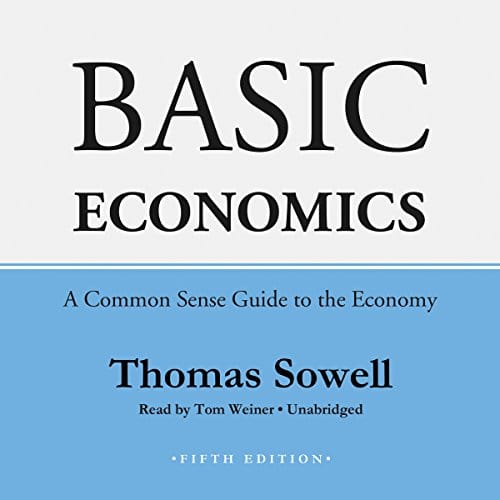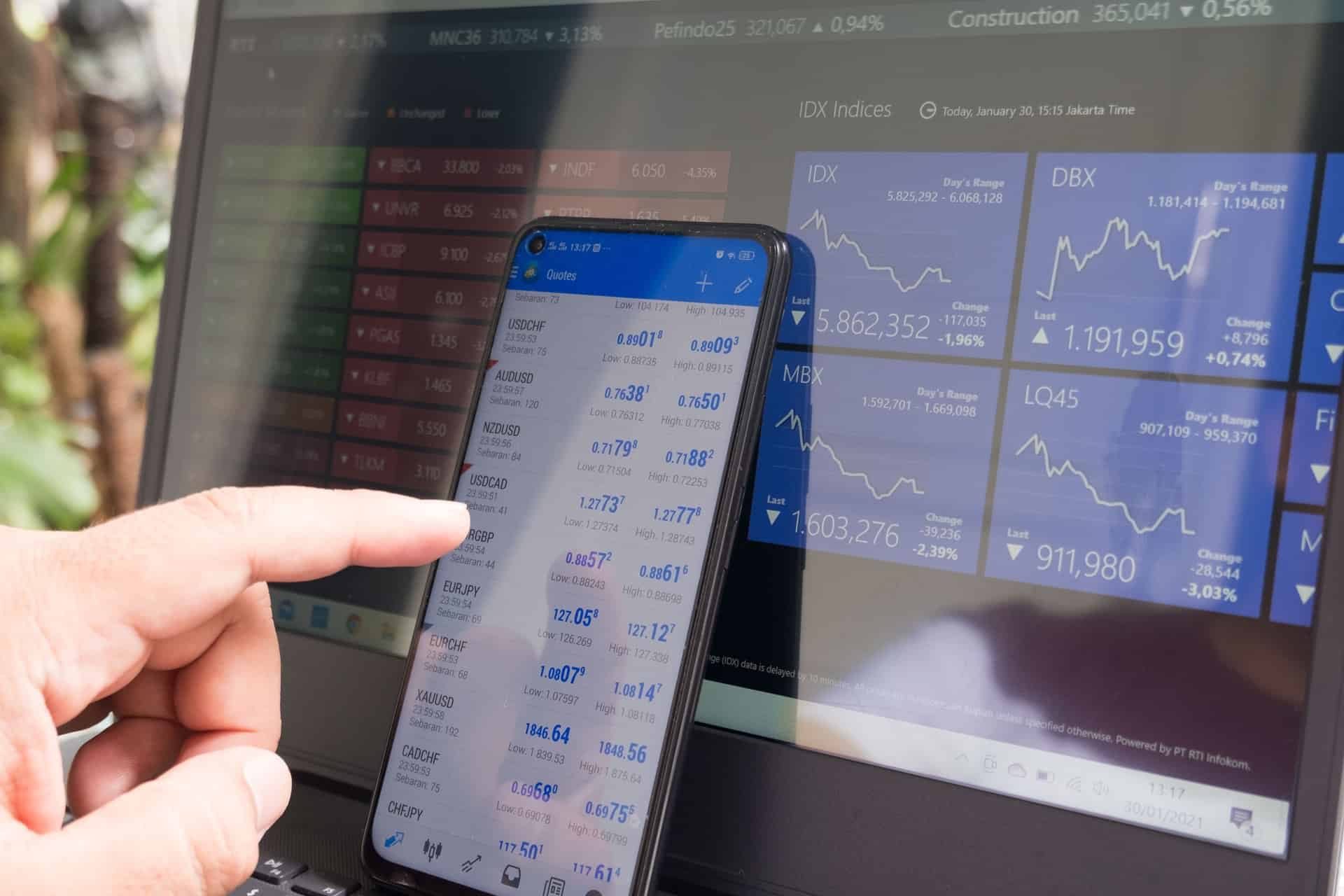Basic Economics by Thomas Sowell | Summary
In Basic Economics: A Common Sense Guide to the Economy, Thomas Sowell explains economics and how they work in an easy-to-understand approach. He discusses the many economic principles underlying prices, businesses, labor, investment, governments, trade, etc. The way a society organizes its governance and economics has significant implications for prosperity or poverty for its people.
Buy Basic Economics on Amazon

Basic Economics by Thomas Sowell
A Common Sense Guide on the Economy
Chapter 1: What is Economics?
“The fundamental principles of economics are not hard to understand, but they are easy to forget, especially amid the heady rhetoric of politics and the media.” In Chapter 1 of Basic Economics, Thomas Sowell introduces the concept of economics, scarcity, and productivity:
- Economy – a system for the production and distribution of the goods and services we use in everyday life
- Economics – the study of the use of scarce resources which have alternative uses
- Scarcity – the wants of everyone add up to more than what exists; without scarcity, there would be no need for economics
- Productivity – the effectiveness of effort as measured at the rate at which inputs are turned into outputs
- Role of Economics – helps us try to make decisions that make the most of the options that we are presented with in life, especially when allocating resources
Download the PDF Book Summary for Basic Economics by Thomas Sowell
Part I: Prices and Markets
In Part I of Basic Economics, Thomas Sowell discusses the interaction of prices and markets.
Chapter 2: The Role of Prices
In Chapter 2 of Basic Economics, Thomas Sowell discusses the importance of prices and shows how resources are allocated:
- Market Economy – an economic system in which production and prices are determined by unrestricted competition between individuals and businesses, not central planners
- Transactions – the instance of buying or selling between consumers, producers, retailers, landlords, or workers on whatever terms they can mutually agree on
- Prices – an amount of money that conveys the terms of the transaction not just to the individuals immediately involved but throughout the entire economic system
- Supply – the tendency of producers to supply more at a higher price and less at a lower price; the quantity supplied varies directly with the price
- Demand – the tendency of consumers to buy more at a lower price and less at a higher price; the quantity demanded varies indirectly with the price
- Unmet Needs – the result of limited resources as some will not get what they need
Chapter 3: Price Controls
In Chapter 3 of Basic Economics, Thomas Sowell discusses price controls of ceilings and floors and how they respectively result in shortages or surpluses:
- Price Controls – government regulations to prevent prices from increasing to levels that would occur naturally from supply and demand
- Price Ceilings – the keeping of prices lower than what they would be, resulting in a:
- Shortage – the result of people demanding more goods or services than what is available, which causes some to hoard goods, the formation of black markets, and deterioration in quality
- Price Floors – the keeping of prices higher than what they would be, resulting in a:
- Surplus – the result of people demanding fewer goods or services than what is available
Chapter 4: An Overview of Prices
In Chapter 4 of Basic Economics, Thomas Sowell talks about how prices alter the decision making of producers, consumers, and the government in an economy:
- Economics – studies the cause-and-effect relationships in an economy to determine the consequences of allocating scarce resources which have alternative uses
- Cause and Effect – analyzing the logic or the incentives that are established and the empirical evidence of what happens under such incentives
- Systematic Causation – involves complicated reciprocal interactions among buyers, sellers, the environment, government, etc.
- Complexity and Causation: “Complex effects may be a result of either simple causes or complex causes.”
- Rationality: Despite things going wrong economically, the actors usually take perfectly rational actions, given the incentives and constraints they face.
- Incentive – something that motivates or drives someone to behave a certain way
- Subsidy – a payment to individuals or firms from the government to make something cheaper
- Tax – a financial obligation for citizens and corporations levied by a government
- Cost – the corporate expense incurred for making a product or providing a service
Part II: Industry and Commerce
In Part II of Basic Economics, Thomas Sowell explores the economics of businesses and the consequences of profits and losses.
Chapter 5: The Rise and Fall of Businesses
A third of new businesses fail to survive two years, while half fail to survive for four years. In Chapter 5 of Basic Economics, Thomas Sowell examines how companies form, grow, and fail. For companies to survive in the long run, they must adapt and respond to the changing conditions, which can include:
- Social – changes in knowledge and insight for the material well-being of society
- Economic – changes within the economy and the financial management of firms
- Technology – improvements in machinery or equipment
- Business Leadership – changes in the personalities and styles that manage firms
Chapter 6: The Role of Profits and Losses
In Chapter 6 of Basic Economics, Thomas Sowell explores the topics of profit, costs, revenue, and specialization and distribution:
Profits = Revenue – Cost
- Profits as Incentives: “The hope for profits and the threat of losses is what forces a business owner in a capitalist economy to produce at the lowest cost and sell what the customers are most willing to pay for.
- Profit Rates – the relative profitability of an investment
- Rate of Return = Profit / Investment
Costs of Production
- Economics of Scale – a proportionate saving in costs gained by an increased level of production
- Diseconomies of Scale – inflection point in “which the cost of producing a unit of output no longer declines when the amount of production increases”
- Costs and Capacity – costs vary to the extent to which existing capacity is being used, as capacity is usually built to handle the max volume of production
- Passing On Costs and Savings – the idea of passing the additional costs or savings from market forces, tax raises/cuts, or tech advances to customers
Specialization and Distribution
- Middlemen – exists as intermediaries between producers and consumers because they conduct their phase of operation more efficiently than others
- Socialist Economies – lack the incentives for enterprises to be more efficient, innovative, and lower costs in production and distribution
Chapter 7: The Economics of Big Business
In Chapter 7 of Basic Economics, Thomas Sowell dives deep into how big businesses operate:
- Corporations – a legal entity that protects the owners from the liability for its financial obligations; the liability is limited to its corporate assets
- Corporate Governance – the firm is run by executives (management) that are employed by the board of directors (ownership), who hold the ultimate authority
- Monopoly – a single company that dominates an industry to the point of excluding all other viable competitors
- Monopoly Prices – a monopolist produces less output with higher prices than a competitive industry produces with similar resources, tech, and cost factors
- Cartel – a formalized organization between a group of producers to regulate supply of a particular good or service to regulate or manipulate prices
Chapter 8: Regulation and Anti-Trust Laws
In Chapter 8 of Basic Economics, Thomas Sowell explores the regulatory landscape:
- Regulatory Commissions – a government agency that sets and enforces standards and pricing for a specific economic sector, which results in inefficiency and poor pricing
- Anti-Trust Laws – laws designed to protect consumers from predatory business practices, prevent monopolies, and ensure competition
- Competition – a market condition in which many firms compute within a sector that is tough to quantify and usually eliminates many competitors
- Control of the Market – the flawed idea that a company’s percentage of sales in a given market describes how much control it has over that market
- Predatory Pricing – an unsubstantiated theory in which a company riskily takes losses by selling below cost to drive out competition
Chapter 9: Market and Non-Market Economies
Today, businesses seem so familiar, but humans didn’t have them for much of history. In Chapter 9 of Basic Economics, Thomas Sowell talks about the private non-profits that provide goods and services, including colleges, hospitals, and museums.
Also, the government conducts business activities that are mainly monopolies and mandates for certain things. Specifically, it provides services like national parks, post offices, and passports.
As a result, many businesses have been displaced as other types of producers due to the cost advantages. Not everyone shares in economic advances, as scarcity results in resources being transferred unequally, primarily if advances in production will raise living standards.
Download the PDF Book Summary for Basic Economics by Thomas Sowell
Part III: Work and Pay
In Part III of Basic Economics, Thomas Sowell discusses all things regarding labor and wages.
Chapter 10: Productivity and Pay
In Chapter 10 of Basic Economics, Thomas Sowell discusses wages and the productivity of labor:
- Wages – the payment for work or a way of allocating scarce labor which has alternative uses as there is always more work than people having the time or skills
- Productivity – the contribution of an employee to a company’s earnings, typically expressed as the amount of output per a given period
- Pay Differences
- Income Distribution – differences in pay due to experience, skills, education, etc.
- Differences and Skills: As the economy becomes more technological and complex, those with higher skills are more demanded and rewarded.
- Capital and Labor: “Capital complements labor in the production process, but it also competes with labor for employment.”
Chapter 11: Minimum Wage Laws
In Chapter 12 of Basic Economics, Thomas Sowell explores all aspects of minimum wage laws:
- Minimum Wage Laws – government regulation making it illegal to pay less than a specified price for labor; typically creates a price floor for workers and results in:
- Unemployment – the percentage of people that are not working but looking for work; there typically is a higher labor surplus under minimum wage laws
- Informal Minimum Wages – imposed minimum wage has a similar impact from customs, informal pressure from the government, public opinion, or labor unions
- Differential Impact: Minimum wage laws impact the employment of those who are younger, less experienced, or less skilled.
Chapter 12: Special Problems in Labor Markets
In Chapter 13 of Basic Economics, Thomas Sowell considers certain labor issues such as underemployment, worker’s rights, collective bargaining, and more:
- Underemployment – the underuse of a worker as their job does not use the worker’s skills, is part-time or leaves the worker idle
- Working Conditions – regulation by the government and labor unions that include safety laws, child labor laws, maximum hours of work
- Collective Bargaining – setting pay and working conditions from either:
- Employer Organizations – groups of employers for an industry
- Labor Unions – groups of employees who negotiate with their employer
- Exploitation: Imposing regulation to prevent consumers or workers from being exploited can actually make things worse, causing pricier goods or more unemployment.
Part IV: Time and Risk
In Part IV of Basic Economics, Thomas Sowell studies the factors of time and risk in economics.
Chapter 13: Investment
In Chapter 13 of Basic Economics, Thomas Sowell examines the concept of investment:
- Investment – the allocation of money or resources, either human capital or financial, for an expectation of a future return
- Return on Investments = Profit / Investment
- Investment Allocation: The interest rate is the price of borrowing and effects allocation:
- Low-Interest Rates: More borrowing occurs as it is more profitable to invest.
- High-Interest Rates: Less borrowing occurs as it is costly, causing more saving.
- Speculation – the investment of scarce resources or knowledge with the hope of substantial gain but with the risk of significant loss
- Inventory – goods available for sale held by a company; substitute for knowledge
- Small Inventory: Running out of goods, which causes customers to go elsewhere.
- Large Inventory: Having excess goods, which raises costs compared to rivals.
- Present Value – the price of money today is worth more than the same in the future
Chapter 14: Stocks, Bonds, and Insurance
In Chapter 14 of Basic Economics, Thomas Sowell discusses three major types of investments of bonds, stocks and insurance:
- Bond – a legal commitment to pay fixed amounts of money on a fixed date, whether the business is making money or losing money
- Stock – a share of the business that issues them with no guarantee that the company will make a profit or payout dividends instead of reinvesting their profits
- Risk – the chance that an investment’s actual return will differ from what is expected
- Diversification – the strategy of investing across various forms of investment to reduce the exposure to any one particular asset or risk
- Insurance – a legal commitment to provide a guarantee of compensation for specified loss, damage, illness, or death in return for payment of a premium
- Moral Hazard – the risk that a party within a contract acts in bad faith or takes unusual risks as they are unlikely to suffer consequences
- Adverse Selection – the tendency of high-risk parties to get insurance or when
Chapter 15: Special Problems of Time and Risk
In Chapter 15 of Basic Economics, Thomas Sowell considers special issues regarding time, risk, and uncertainty:
- Uncertainty: Risk is calculable, but uncertainty is not. Uncertainty can cause investors and consumers to be reluctant to spend money, which adversely affects the economy.
- “Time is Money:” “It means that whoever has the ability to delay has the ability to impose costs on others – sometimes devastating costs.”
- Economic Adjustments: “The consequences of decisions unfold over time—and markets adjust at different rates for different decisions.”
Download the PDF Book Summary for Basic Economics by Thomas Sowell
Part V: The National Economy
In Part V of Basic Economics, Thomas Sowell explores the national economy from a macro perspective.
Chapter 16: National Output
In Chapter 16 of Basic Economics, Thomas Sowell examines the productivity and output of a national economy:
- Fallacy of Composition: The flawed assumption that what applies to a part of the economy applies to the whole, which ignores the interactions between actors.
- Output and Demand: The demand for goods and services, indicated by consumer spending, drives the total level of output in the economy.
- Gross Domestic Product (GDP) – measures national output by summing all goods and services produced within a nation’s borders
- Consumer Price Index (CPI) – measures inflation from the average change in prices over time that consumers pay for a grouping of goods and services
- GDP per Capita – measure indicating national prosperity based on economic growth
Chapter 17: Money and the Banking System
In Chapter 17 of Basic Economics, Thomas Sowell explores the role of banks and money:
- Money – a medium of exchange used to transact goods and services in an economy
- Inflation – a decrease in the purchasing power of money seen in a rise in prices
- Deflation – an increase in the purchasing power of money seen in a fall in prices
- Banks – a business that allows people to borrow money and safety deposit their money
- Banking System – the system of financial intermediaries enabling many people to spend money that belongs to many other strangers for investments or consumer purchases
- Fractional Reserve Banking – the requirement for banks to hold a fraction of reserve money to cover deposits, using the remaining capital for lending
Chapter 18: Government Functions
In Chapter 1 of Basic Economics, Thomas Sowell discusses the role of governments:
- Governments establish and enforce a framework of law and order that govern the economy, underlines contracts, and allows for market transactions to take place.
- Property Rights – define the legal ownership of resources and how they can be used
- Social Order: “While a market economy operates better in a country where honesty is more widespread, it is also true that free markets tend to punish dishonesty.”
- Externality – an external cost or benefit caused by a producer that is not financially incurred or received by that entity; governments try to enact laws to offset their effects
- Incentives and Constraints: Before having the government solve a problem and expand its role, the incentives and constraints need to be examined. Or else the government will get bigger and more powerful.
Chapter 19: Government Finance
In Chapter 19 of Basic Economics, Thomas Sowell discusses the aspects of government finance:
- National Debt – the accumulation of government budget deficits over time
- Government Revenues – allow governments to operate from the following sources:
- Taxes – mandatory contributions collected by governments, which sets tax rates, but public reaction to the tax determines how much total revenue is collected
- Government Bonds – a security sold by the government to borrow money to be repaid from future tax revenues
- Charges – governments sell goods and services like mail, passports, trains, etc.
- Government Expenditures – the money spent by the government, which tends to spend more during recessions and let during economic booms
- Government Budgets – the projection of the government’s future revenue and spending
Chapter 20: Special Problems in the National Economy
In Chapter 20 of Basic Economics, Thomas Sowell considers specific issues in the national economy, including the scope of policy and the failure of governments:
- Scope of Government: Some decisions are clearly political, while the government or marketplace could do others. When deciding between the two, “it is necessary not only to decide which particular outcome would be preferred but also which process offers the best prospect of actually reaching that outcome.”
- Monetary Policy – a set of tools used by a nation’s central bank to regulate the overall money supply and achieve sustainable growth of the economy
- Market Failure and Government Failure: “The imperfections of the marketplace have led many to see government interventions as necessary and beneficial. Yet the imperfections of the market must be weighed against the imperfections of the government whose interventions are prescribed.”
Part VI: The International Economy
In Part VI of Basic Economics, Thomas Sowell expands to talking about the global economy.
Chapter 21: International Trade
In Chapter 21 of Basic Economics, Thomas Sowell shows that international trade takes place because the two or more nations win due to three reasons:
- Absolute Advantage – the ability for one country to produce goods and services cheaper or better than its trading partners
- Comparative Advantage – the ability for one country to produce specific goods or services at lower opportunity costs than its trading partners
- Economics of Scale – the enormous levels of production that enable nations “to sell at prices that can compete with the prices of similar products in the world market”
International Trade Restrictions
Most arguments for protections are fallacies, including that these restrictions maintain high wages, save jobs, protect infant industries, promote the national defense, and prevent the dumping of inferior products:
- Tariffs – the taxes on imports of goods that raise the price of imports
- Import Quotas – the limits placed on quantities of specific imported goods
Chapter 22: International Transfers of Wealth
In Chapter 22 of Basic Economics, Thomas Sowell looks at international transfers of wealth:
- International Investments: Typically, more prosperous nations tend to invest in other wealthy countries because investors look for stability, efficiency, and the expectation of returns.
- National transfers of wealth have primarily occurred between people by remittances and immigration, while national policies of imperialism and foreign aid have had little effect.
- International Monetary System – the system and rules governing the exchange of currency between countries as most transfers occur by currency, not goods and services
Chapter 23: International Disparities in Wealth
In Chapter 23 of Basic Economics, Thomas Sowell explores several factors for the disparities of wealth that occur globally:
- Geographic Factors: Several physical factors can affect a country’s economic prosperity, including the soil makeup for farmland, water access for transport and trade, mountains affecting weather and isolation, and availability of animals for food and production.
- Cultures: Cultural differences also account for national wealth disparities, the promotion rule of law and order, attitudes toward work and economic development, idea sharing between diverse backgrounds, and the utilization of human capital.
- Population: Population density does not seem to affect prosperity. Rather, it’s improved through the productivity of people, which depends on their habits, skills, and experience.
- Migration: Humans have migrated throughout time, dispersing technology causing significant advancements, and adopting cultures changing people’s mindsets.
- Imperialism: Conquests have exchanged wealth, culture, and people; however, there is little “evidence that current economic disparities between nations in income and wealth can be explained by a history of imperial exploitation.”
Part VII: Special Economic Issues
In Part VII of Basic Economics, Thomas Sowell examines a few notable economic problems.
Chapter 24: Myths About Markets
In Chapter 24 of Basic Economics, Thomas Sowell discusses several myths about markets:
- Myth of Prices: “Prices have been compared to tolls levied for private profit or to barriers which, again for private profit, keep the potential stream of commodities from the masses who need them.”
- Brand Names – “a way of economizing on scarce knowledge, and of forcing producers to compete in quality as well as price”
- Nonprofit Organizations – “are under very little pressure to achieve their institutional goals to the maximum extent possible with the resources at their disposal.”
Chapter 25: “Non-Economic” Values
In economics, trade-offs are inescapable if there is scarcity and alternatives within resources. In Chapter 25 of Basic Economics, Thomas Sowell explores morality in markets. The market gets wrongly blamed for obstructing values, perpetuating greed, and being amoral.
For example, saving lives is a common argument for creating specific economic policies. “If a life is not of infinite value, then it cannot be true that “if it saves just one life,” some device, law, or policy is worth whatever it may cost. Certainly, it cannot be true if the cost of saving one life is sacrificing other lives.”
Chapter 26: The History of Economics
In Chapter 26 of Basic Economics, Thomas Sowell reviews a few highlights of the history of economics.
Classical Economics
- The Mercantilists – “argued for policies enabling a nation to export more than it imports, causing a net inflow of gold to pay for the difference”
- Adam Smith – the father of modern economics; proposed that free markets could self-regulate through competition, supply and demand, and self-interest
- David Ricardo – known for theories on wages and profit, labor, comparative advantage, and rents
- Say’s Law – the income generated from past production and sales is the source of spending that drives demand to buy current production
Modern Economics
- The Marginalist Revolution – divided classical and modern economics by proposing a theory that asserts individuals make decisions “on the margin”
- Equilibrium Theory – shows how the interactions of supply and demand cause a balancing in an economy, creating an equilibrium of prices
- Keynesian Economics – a theory that focuses on using government policies and intervention to manage aggregate demand to deal with or prevent recessions
- Post-Keynesian Economics – “found the market more rational and more responsive than the Keynesians had assumed—and the government less so”
The Role of Economics
- “Is economics scientific or is it just a set of opinions and ideological biases?
- Do economic ideas reflect surrounding circumstances and events and change with those circumstances and events?”
Chapter 27: Parting Thoughts
In Chapter 27 of Basic Economics, Thomas Sowell concludes that new economics fallacies are being invented or misconstrued while old ones are still being refuted. Many economic fallacies depend upon:
- “Thinking of the economy as a set of zero-sum transactions,
- Ignoring the role of competition in the marketplace, or
- Not thinking beyond the initial consequences of particular policies.”
Download the PDF Book Summary for Basic Economics by Thomas Sowell
Next Steps
In Basic Economics, Thomas Sowell discusses the concept of economics and its inner workings in a common-sense manner. It is vital that a society organizes its governance and economics properly to result in a prosperous future for its people. For more, get your own copy of Basic Economics.







